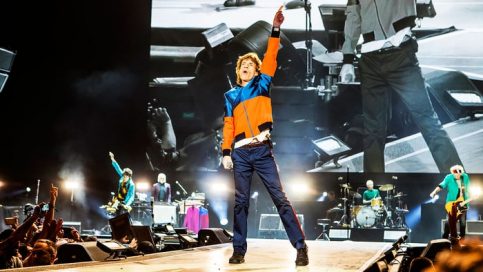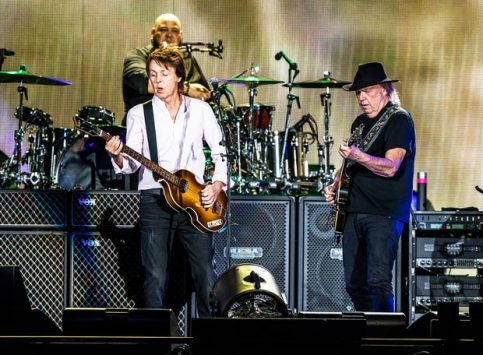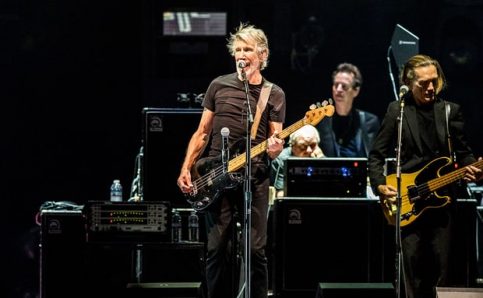It was inevitable. Mick Jagger, who coined the phrase “Coachella for old people” last spring to describe Desert Trip, cracked the first jokes about aging rock stars from the stage, during the Rolling Stones‘ opening-night set on October 7th. The singer dubbed the festival – featuring six of rock’s biggest still-working legends of the Sixties and Seventies – “the Palm Springs retirement home for genteel English musicians.” Then Jagger asked if anyone remembered “the late Eighties” before the Stones jumped into “Mixed Emotions” from 1989’s Steel Wheels.

The Stones were also the first act at Desert Trip to fire up new material. They played “Ride ‘Em on Down,” a Jimmy Reed cover from their forthcoming album, Blue and Lonesome, and debuted an unexpected romp through the Beatles’ “Come Together” that sounded like the Stones had written it instead for 1969’s Let It Bleed. The next night, with his rowdy, young band Promise of the Real, Neil Young mixed crowd-pleasers like “Heart of Gold” and the 22-minute guitar bonfire “Down by the River” with unreleased grenades such as “Neighbors,” with its lyric reference to a “terrorist suicide hang glider.” Also on October 8th, Paul McCartney scored a first when the ex-Beatle jammed with Young on “Why Don’t We Do It in the Road” from 1968’s The Beatles, a song McCartney had never before played live.
And right after the second presidential debate on October 9th, former Pink Floyd singer-bassist Roger Waters closed Desert Trip’s inaugural weekend with the U.S. debut of a politically charged visual spectacle of all-Floyd songs that peaked with an explicit hammering of Republican candidate Donald Trump in “Pigs (Three Different Ones)” from 1977’s Animals – across a gargantuan recreation of that LP’s cover image, London’s Battersea Power Station, complete with working chimneys.
“We put it together in the last four months,” Waters revealed proudly in his backstage trailer two days before the show. “The professional comes out in you: ‘What if we build Battersea Power Station – in the middle of the desert? How fucking cool would that be?’ And we’ve done it.”

For all of the judgmental buzz leading up to Desert Trip – mainly about the nostalgic weight of the bill, which also featured Bob Dylan and the Who, and its unprecedented financial scale with three-day tickets as high as $1,599 and a projected gross of $160 million across two weekends – the festival was a celebration of enduring songwriting and vintage zeal in performance: an affirmation of the restless, often competitive edge that produced this generation of rock stars, in rock’s most revolutionary decade. The Who ran through virtually the same set they have taken around the world since 2014 but with virile, renewing force even in the most familiar moments: Roger Daltrey’s epic howls in “Love Reign O’er Me” and “Won’t Get Fooled Again”; the instrumental rush of guitarist Pete Townshend and drummer Zak Starkey in the Tommymedley. After watching the Stones pull out their Beatles cover, McCartney returned the favor in his encore, playing the former’s first Number One hit in the U.K., “I Wanna Be Your Man” – not before pointing out that he and John Lennon wrote it and gave it to the Stones.
Dylan was predictably confounding in his kickoff set at sundown on October 7th. He started with a handful of classics – “Rainy Day Women #12 and 35,” “Highway 61 Revisited” – but soon veered into a roundabout tour of his history: going from the Nineties ballad “Make You Feel My Love” to the recent crusty noir of “Pay in Blood,” then turning back to 1965 with a turbulent, electric “Desolation Row.” For most of his set, the crowd could not see Dylan on the giant video screens, just old newsreel footage; the singer reportedly ordered the stage cameras shut off after a few songs because he didn’t like what he saw in the monitors.
Still, backstage the next day, producer Don Was declared it “one of the best Bob Dylan shows I’d ever seen. He didn’t throw a single line away. And the band was crackerjack.” The groove “created a continuity over decades,” Was told Sirius XM, even though the songs weren’t “necessarily linked other than that they come out of Bob’s point of view.” Was, who worked on the Stones’ new album, also mentioned that he saw the band before they took the stage. “They were very relaxed,” Was said. “They played for fun.” But even he was taken aback by that Beatles cover. “I think it was a lark at rehearsal.”
Desert Trip itself was a more intricate undertaking – and a genuinely unique summit meeting. Of the six acts, only the Who appeared at rock’s first two landmark festivals, Monterey Pop in 1967 and Woodstock in 1969. (Young was at Woodstock with Crosby, Stills, Nash and Young but refused to appear in the movie.) In his trailer, Waters recalled that Paul Tollett, president of Coachella promoter Goldenvoice, first approached him last November. “He said,
‘If I could put together a weekend with you, Neil, Dylan, the Stones, Macca and the Who, would you do it?’ He wanted an agreement – not a contract but a letter in principle.”
Waters believed that “everyone said yes in principle” early on but that it was harder “getting people to sign contracts.” The average payday for each of the six acts is an estimated $7 million apiece, nearly half of Desert Trip’s total production costs of $100 million.

Despite the mocking hype about the performers’ average age, 72, and the more than 1,000 flushing toilets accommodating those ticket buyers not that far behind, Desert Trip was a refreshingly egalitarian experience, based on tours around the grounds. While the best reserved seats on the ground and in the grandstands were padded with cupholders, the audience in the standing-only pit was closest to the stage and skewed much younger. The Desert Trip Culinary Experience was an upper-crust dining facility with an air-conditioned lounge and artisanal desserts. But general admission tickets, at $199 a day, included access to a wide array of chow and drinks (from burgers and craft beers to vegan and Chivas Regal) as well as a extensive rock-photography exhibition. A pop-up vinyl shop operated by the Glass House, an independent music venue in Pomona, California, sold used LPs for as little as $3.00 and 45s at a buck apiece.
Speculation is already running high about the artists that might play Desert Trip 2. Goldenvoice has not publicly confirmed an event for 2017, but names that came up most often during conversations in the crowd were Elton John, Bruce Springsteen, Stevie Wonder and Fleetwood Mac. Meanwhile, for the acts at this year’s Trip, it’s business as usual after the second weekend. Dylan is on the road through late November, and the Who have dates booked into next spring. The Stones release their new blues album in a few weeks; Young has an acoustic record coming in December; McCartney is working on new music; and Waters is making his first solo, studio album since 1992 with Radiohead producer Nigel Godrich.
Ultimately, Waters said, Desert Trip was “always somebody with a guitar singing something really heartfelt. When it went on sale, nobody knew how it was going to go. It was a crazy idea. But I’m glad I’m here.”
By David Fricke

You must be logged in to post a comment Login